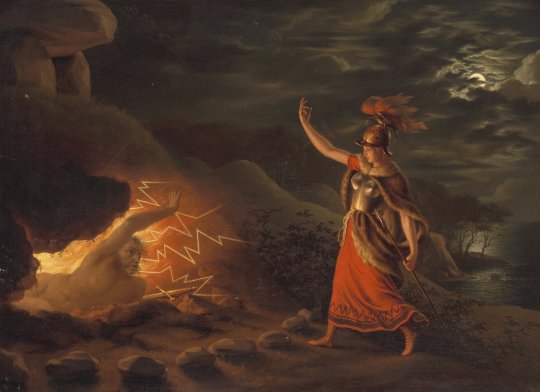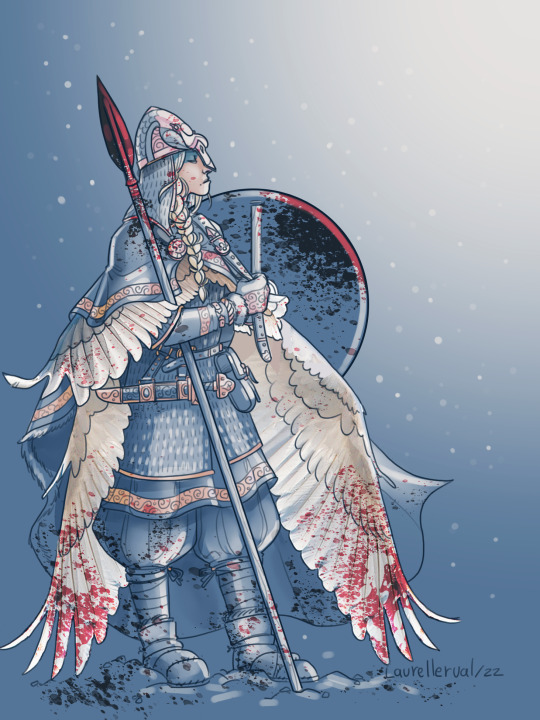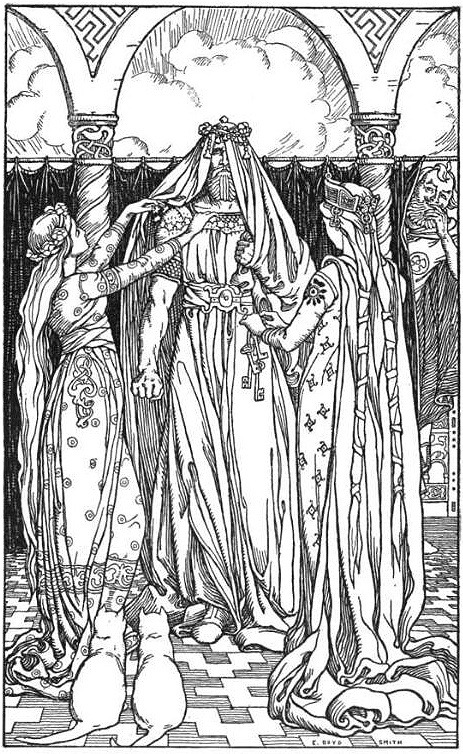#poetic edda
Text

Hervör retrieves the sword from Angantýr by Christian Gottlieb Kratzenstein Stub
Hervör awakens her father Angantýr's ghost from his barrow on Samsø to demand the cursed magic sword Tyrfing
#hervor#angantyr#art#barrow#burial mound#christian gottlieb kratzenstein stub#hervarar saga#waking of angantyr#poetic edda#norse mythology#samsø#tyrfing#tyrfingr#magic sword#sword#shieldmaidens#shield maiden#heirloom#cursed#germanic heroic legend#sagas#scandinavia#europe#european#northern europe#haunted#enchanted#shieldmaiden#history#medieval
54 notes
·
View notes
Text
On God of War and "canon" in Norse mythology
Playing God of War: Ragnarök and reading writing about it reminds me of something a lot of people have trouble internalizing about Norse myth, which is is that
The vast, overwhelming majority of Norse mythology is lost
and
There is no "canon" in Norse mythology
The concept of "canon" in religion is, at least in the west, very much a Christian thing (yes, it's also a feature of other religions). The idea that there is an authorized, central, divinely ordained, "official" central set of facts which are true, and everything else is fanfiction at best or heresy at worst.
And this is something we've taken with us into our general media criticism, hundreds of thousands of words exchanged between people debating which parts of Star Wars or the MCU are canon, or endlessly cycling through interpretations of what parts of Tolkien's mythos apply to each part of the Lord of the Rings or the Hobbit. I've participated in those discussions, and they can be a lot of fun, but it's worth remembering that this is only one of multiple ways to approach writing and narrative.
Norse mythology has no canon. There is no set of texts that have been declared by any central authority to be "the truth" of the Allfather, or the most correct depiction of Thor. Even in its own time, before its suppression by Christianity, Viking-age sailors, farmers and warriors would not have understood their religious practise as bounded by a finite and defined set of stories. It was an oral tradition, transmitted by telling and re-telling.
Your skjald knows some stories of the gods, maybe the guy the next town over knows some different ones, and maybe you go on a trading journey with a guy from Norway who knows completely different stories and you take those home with you where they become a part of the local rotation.
The primary sources for most Norse mythology (and certainly for God of War: Ragnarök) are the Prose Edda and Poetic Edda, two collections of texts compiled in the 13th century in Iceland by Snorri Sturluson, a Christian poet and politician, as well as possibly other contributors at the same time.
They are limited by their geography, consisting only of those stories that survived in Iceland, and limited by their time period. The Viking Age is generally considered to have ended around 1050 CE, so Sturluson was compiling these stories two hundred years after the time when Norse paganism would have been the dominant religious practise in Scandinavia or indeed Iceland.
We have other sources than the Eddas, of course, but they are painfully limited: Runestones and archeological artifacts, as well as stories told about the Vikings by people who weren't them, which obviously comes with a lot of biases. The Viking-era Scandinavians themselves simply didn't leave any substantial body of written sources that survived.
Sturluson being a Christian, writing for Christian audiences, also introduces a lot of suspicion of tampering. He might have had incentive to avoid recording certain stories, for fear of being accused of spreading heresy, and he may have edited or altered aspects of the stories he did record to make them palatable to his audience, or to serve his own political purposes. This, of course, is a concern with any author writing anything ever, but since Sturluson is quite literally our only source for so many of these stories, it is impossible to check his work against competing narratives.
The consequence of all of this is that the vast majority of Norse mythology is lost. We do not know the vast majority of what that old religious practise was, we do not know the vast majority of its stories. This was a set of beliefs and stories told and transmitted across populations ranging from what is now the inland plains of Germany to the heights of the mountains of Norway to the shores and harbors of Denmark to parts of modern day Russia. These disparate populations would have had an absolutely enormous range of shared and local religious practises, they would have emphasized and cared about different gods, they would have absorbed and incorporated stories from neighboring religious groups.
This has a couple of consequences. For one thing, the whiny pissbabies crying about Angrboða being portrayed as a person of color in God of War: Ragnarök because "there were no black people in Norse mythology!" are, indeed, full of piss and expired baby oil. They don't know that, because nobody knows that.
Viking sailors made it as far as Constantinople and old Norse was once spoken in parts of Crimea. They even managed to make it across the goddamn Atlantic to found a settlement in Newfoundland, so the idea that old Norse peoples wouldn't know what a person of color is or tell stories about them is just absurd on the face of it. We have no direct evidence that they told stories about gods of color, but to look at the tiny snapshot provided by one Christian poet writing for a Christian audience in Iceland two hundred years after the Christianization of Scandinavia and confidently concluding that people of color couldn't possibly have existed in the Norse imagination is like finding the Q key off a keyboard lying on the ground and concluding there can be no such thing as vowels or the letter L.
The tiny sliver of Norse mythology that has survived to the modern day should to a modern reader be a prompt to imagine the vast possibility of what has been lost, not a reason to reduce the entire culture of my ancestors to whatever bits that were left by the time some dude in Iceland found it interesting and convenient to write them down.
Which leads us on to the other interesting consequence of the facts of Norse mythology.
It is an oral tradition, with no central canon and no central authority, whose religious practises were local and varied, whose stories were designed to be shared and picked up by whoever finds them compelling. Which means that any story we tell, now, about the gods that we find compelling is every bit as "canon" as anything that survives in the Eddas.
Which is to say: not canon at all, unless you decide to believe in it. Or, hell, even if you just find it enjoyable.
God of War: Ragnarök is as canon as Neil Gaiman's Norse Mythology is as canon as Jul i Valhal that ran on Danish TV in 2005 is as canon as the MCU Thor, is as canon as the Prose Edda, is as canon as the half-remembered re-telling of Norse myth I heard from my Danish teacher in class in 1998.
It is often very difficult for a lot of modern audiences to free themselves from the idea of "canon." We seem to instinctively want a certain set of stories to be "the real ones," a certain narrative to be the "official" one, and set adrift without that sense of central authority to guide us, a lot of people exhibit what I would call an almost resentful anxiety. If none of it is definitely true, then what is even the point of any of it? If you can't know for sure which story is the most real, then all of it must be meaningless!
And yeah. It's easy to feel that way. We live in the Age of Canon, the era of the cinematic universe and the franchise, the epoch of copyright. But that is only one way to understand stories and narrative.
If you listen to the stories of the old gods, whether out of the Eddas or re-told in pop culture, and you take some of that with you, and you pass the good bits on to someone else, then you are participating in the oldest and most sacred tradition of Norse mythology. These stories do not belong to any one author (especially not the goddamn Mouse!) or even to any one people. They were telling stories of Thor along the rivers of Russia a thousand years ago, Viking sailors scratched their names in runes in the Hagia Sophia, Islamic artifacts have been found in Viking burials. Those who look at the tradition of my ancestors and feel compelled to do enclosure around them are fools and charlatans, fearful and small-minded.
Our stories are monopolized these days by capital. Canon to them is a tool of enclosure, a way to shut people out of participating in the modern mythology they are trying to build, except with their permission and profit in mind. But there is another way.
Listen to the stories and pass them on. The story you believe in won't be the one everyone likes, and the version you tell won't be the same version someone else passes on from you. But every telling takes the soul of the teller with it, and the stories we weave together in communal tradition become a picture of every storyteller who has contributed to them. And you spite the fucking Mouse.
#tb essay#god of war#gow ragnarok#norse mythology#norse gods#history#prose edda#poetic edda#loki#thor#odin#angrboða
1K notes
·
View notes
Text

Sneak peek of my college project
57 notes
·
View notes
Text

An inkwork runestone Yggdrasil design to accompany the Völuspá in the illustrated runic Poetic Edda I'm working on.
159 notes
·
View notes
Text
"Write Havamal but in haiku meter", I said, "it'll be a fun project".
Well, after writing not even half of the poem into 101 haikus so far, I am seriously regretting my life choices.
#heathen poetry#heathenry#heathen#north sea poet#poetry#nico solheim-davidson#havamal#norse mythology#poetic edda
46 notes
·
View notes
Note
For the fanart, could you do Val full shieldmaiden stlye, post-battle?

I am so proud of this! I love it, if I can say so myself.
I think that the equipment of the skjaldmær (shielmaiden) is quite historically accurate.
The swan feather cloak is not. I chose it because Val, shieldmaiden version, reminded me of Hervör (also a shieldmaiden from the Hervarar saga ok Heiðrek). And Hervör + Val reminded me of the homonymous valkyrie from the Vǫlundarkviða, also a swan-maiden.
I hope you like it :)
#val#asoiaf#freefolk#vikings#hervor#norse mithology#asoiaf fanart#art#mitology#poetic edda#valkyrie#medieval literature
411 notes
·
View notes
Text
Queen Grimhild: Sigurd's just so hot, and nice, and gorgeous.
Gudrun: Sigurd is also in a relationship.
Queen Grimhild, looking at Brynhild: People die, get kidnapped or disappear in mysterious ways all the time. I can wait.
#OR people get magic potions that make them forget about their promises to their one true love by their evil mother-in-law#CONTEXT for those unfamiliar: Sigurd is a cute hero with invulnerable skin who is in love with a beautiful girl named Brynhild#but some other queen.. Grimhild.. wants Sigurd to marry HER daughter Gudrun instead.. but she knows Sigurd will never agree while he loves-#-Brynhild. so she gives him a magic potion to make him forget about his love for Brynhild.. and instead he marries Gudrun#and his best friend.. Grimhild's son Gunnar.. marries Brynhild instead#and Brynhild gets pissed and kills everyone and then has a moment of grief and kills herself on Sigurd's pyre. lol.#sigurd#siegfried#grimhild#gudrun#sigurd x brynhild#brynhild#norse mythology#norse gods#norse heroes#incorrect norse mythology#incorect norse heroes#incorrect norse gods#volsunga saga#poetic edda#mythology#incorect mythology#queuetzalcoatl
34 notes
·
View notes
Text
Nine Noble Virtues

Courage
Truth
Honor
Fidelity
Discipline
Hospitality
Self-reliance
Industriousness
Perserverance
The Nine Noble Virtues Of The Vikings
Viking Honor System.
#nine noble virtues#vikings#nordic#nordic virtues#courage#truth#honor#fidelity#discipline#hospitality#self reliance#industrious#perserverance#norse mythology#mythology#viking#poetic edda#ragnar lothbrok#ragnar#nordic leadership#honor system#society#culture#history#code of honor#key principles
65 notes
·
View notes
Text
Cattle die, kinsmen die,
the self must also die;
I know one thing which never dies:
the reputation of each dead man.
-"Sayings of the High One (Havamal)" 77, from the Poetic Edda, trans. Carolyne Larrington
49 notes
·
View notes
Text

I love the implications of this throwaway line in Loki Season 2.
#loki season 2#marvel loki#baldr#death of baldur#mobius#loki series#marvel mcu#mcu thor#mcu odin#myth loki#loki#norse mythology#scandinavian mythology#viking mythology#old norse#paganism#asatru#vikings#viking#poetic edda
16 notes
·
View notes
Text
What people need to understand about the Edda

To continue on my rant about the middle ages, let me quickly verge into the area of the Norse. To start, please remember: The culture was named "the norse", viking was just a job description so to speak. The vikings were all norse, but not all norse were vikings.
Here is the thing: Every kind of fantasy nerd loves the edda. No matter whether we talk the prose edda or the poetic edda. It does also not matter whether we are talking queer fantasy nerds - or the kinda white conservative one. Sure, they gonna focus on very different parts of the edda, but they sure fucking love the edda never the less.
There is only one problem a lot of folks do not talk about: The Edda is not really a good source. Because it was not written down by the Norse, it was written down by Snorri Sturluson, who was a Christian and he very much imposed his Christian views onto the Edda. Or to phrase it differently: We actually do not know a lot about the actual Norse mythology, partly because the Norse did not use their runes to write anything down, partly because a lot of religious sites and idols were once again destroyed as Christianity became the main religion adopted by the Norse.
Loki is the best example. We... actually do not know whether there was a god named Loki in the actual Norse mythology. Because outside of the Edda we have little to no evidence for it. And what little evidence we have does not point towards Loki, the trickster, but rather Loki, god of the heath. And we can see that a lot of the symbolism used for Loki actually does mirror very well typical medieval symbolism of Satan. Which would also explain why Loki does a lot of bullshit and gets away with it - until he doesn't and ends up with that "cruel and unusual punishment", you know?
Yes, it is to assume that quite a few aspects of the Edda are very much based on actual mythology. We have enough evidence of some of the gods existing and being prayed to, like Odin and Thor for example. We also have more than enough evidence for the people believing in dwarves and elves to some degree. But the details of most of the stories? Yeah, that is actually a lot more questionable. Because if you look at it from a comparative lense, you will actually find a lot of Christian influences in there.
This is also why this is a whole field in comparative mythology: Trying to find all those Christian influences in the Edda and then analyse why they are there and go by context and historical findings to get an understanding of what the original mythology might have been before that.
I might note, that the Norse mythology still is a lot more complete in our understanding, of course, than the Gaelic mythology. Because in the way the Gaelic mythology was written down we find a lot more stuff that clearly has been added from a Christian point of view. Like the tuatha de danann being linked to fucking Moses.
But I am really begging people to not always go "Well, actually" when it comes to Norse mythology, because even if you have memorized the Edda word for word... you still are mostly guessing which parts are Christian influence and which parts are actually Norse.
#mythology#history#medieval history#norse mythology#norse#vikings#viking age#valhalla#poetic edda#christianity#comparative mythology
39 notes
·
View notes
Text

Nótt riding Hrímfaxi by Peter Nicolai Arbo
#peter nicolai arbo#art#nótt#night#hrímfaxi#horse#hrimfaxi#norse mythology#germanic mythology#norway#norwegian#northern europe#horses#prose edda#poetic edda#europe#european#scandinavia#scandinavian#nordic#norse#old norse#snorri sturluson#mythology#sky
111 notes
·
View notes
Text

I like to draw Angrboda🌞🌚❤️
#character#my art#fantasy#illustration#mythology#norse gods#norse#angrboða#angrboda#poetic edda#elder edda#gods#digital painting#forest#digitalart
414 notes
·
View notes
Text

While Freyja's cats look on, the god Thor is unhappily dressed as Freyja in Ah, what a lovely maid it is! (1902) by Elmer Boyd Smith.
#this caption is sending me#‘while Freyja’s cats look on’#Thor#freyja#norse mythology#Elmer Boyd Smith#Þrymskviða#poetic edda
228 notes
·
View notes
Photo

Sigrdrífumál - Brünnhilde greeting the day with Siegfried
#but i made it my opt booyaaaaa!!!!!#brunnhilde#siegfried#brynhildr#sigurd#I based my siegfried's design from Dr Jackson Crawford description of him in his book#logh#legend of the galactic heroes#siegfried kircheis#reinhard von lohengramm#lol 10 years later and they still don't have ship name#pimsriart#illustration#poetic edda#norse myth#norse mythology
353 notes
·
View notes
Text
Fenrir howls terribly
before the doors to Hel;
the wolf will break its bonds
and run.
I know much wisdom,
I see deep in the future,
all the way to Ragnarok,
a dark day for the gods.
— Voluspa 43
#voluspa#ragnarok#fenrir#the wolf#wolf#norse#poetic edda#edda#eddas#norse lore#norse mythology#norse religion#religion#old norse#viking#vikings
43 notes
·
View notes